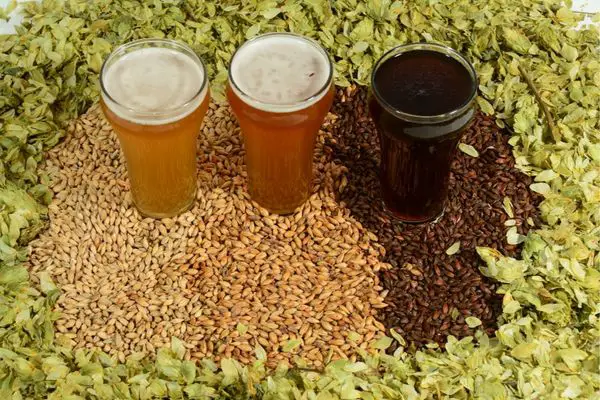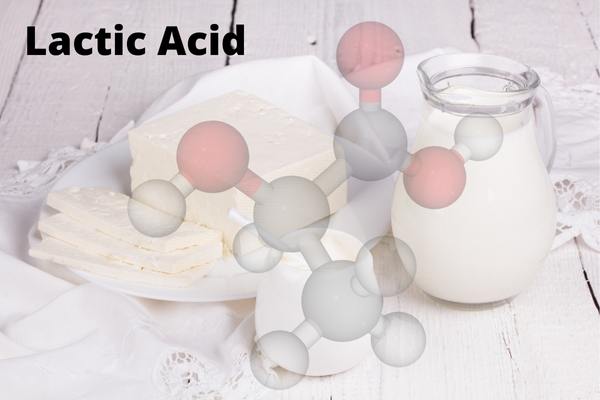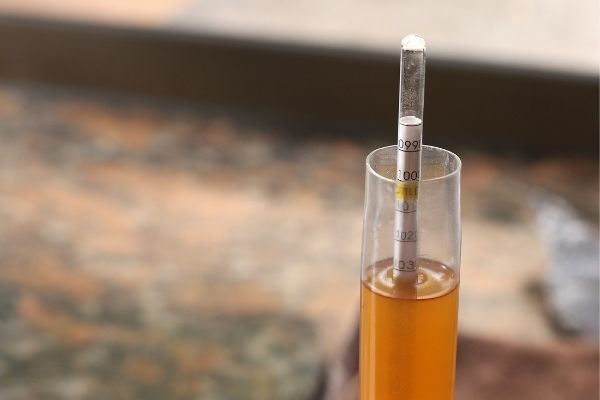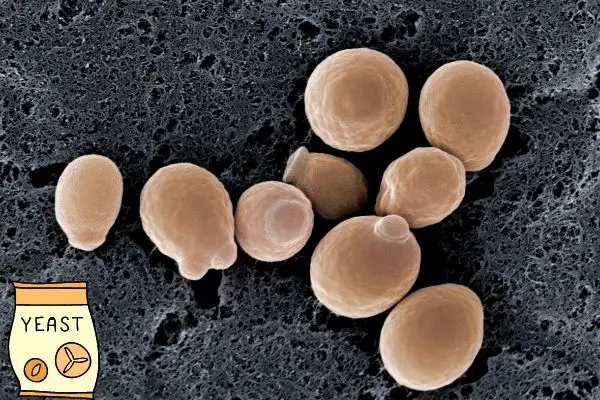Making hard cider is a process that has been around for centuries, and the taste of hard cider has evolved over time.
To make cider taste more to your liking, it is important to understand where the different tastes come from in the first place.
You might want to reduce the beer taste or the acidity and tartness of your cider and there are many different ways to do so, depending on the stage of the fermentation process.
For example, to reduce the taste of beer or yeasty mellow bitterness in your cider, use a wine or champagne yeast and rack the cider often. To reduce the tartness in cider, encourage malolactic fermentation or back-sweeten the cider.
The same tricks will work for too-acidic ciders.
Of course, the taste of cider is up to personal preference, but there are indeed traditions and guidelines for how real hard cider should taste.
And remember that a good cider starts with the types of apples used, so these should be considered carefully as well!
Should hard cider taste like apple cider?
The short answer is no. It should taste more like wine, but it is more complicated than that.
Many people think that hard cider should taste like apple juice with a bit of alcohol, but this would be like comparing grape juice to wine or vodka with potatoes (well, not quite but you get the idea!).
Think of hard cider more as a wine than apple juice, and you will appreciate it much more.
Hard cider is apple juice (or cider) that has had its sugars converted to alcohol and it is therefore much less sweet than non-fermented cider.

In addition, other nutrients such as amino acids and minerals are converted into yeast growth (biomass) and the yeast releases different aromatic compounds by converting existing compounds already present in the juice or completely novel aromatic compounds created through its metabolism.
There may also be different flavours added by the storage and aging of the cider as an oak or chestnut cask (as traditionally used for Spanish cidre natural), which will add tremendously to the taste.
Also, the apples used for making apple cider are quite a lot different from those most people would use for plain apple juice.
Cider apples are usually much more tart, sour and astringent so that when the sugar is gone after fermentation, there is still a rich flavour profile to be enjoyed.
How to reduce the beer taste in cider?
The beer taste in cider comes from the bitterness provided by the alcohol and other bitter compounds, the flavor compounds released by the yeast (including the taste of yeast itself!), and the sweetness being left behind.
So choosing the right yeast for you cider is key to getting the taste you want!
These beer-like tastes are often most present in English ciders that are made with higher alcohol contents and the use of more traditional beer yeasts.
If you have not already made your cider, make sure to use a wine or champagne yeast if you wish to minimize the beer taste.

You will also want to rack your cider as often as possible e.g. every 3-4 weeks to avoid the precipitated yeasts from breaking and releasing those beer-like flavor compounds into your cider.
The apples used as the starting point of the cider are also important. If you use sweeter, less acidic, apples, you end up with a more mellow beer-like drink.
If you, on the other hand, use traditional French or Spanish cider apples sour like Raxao, Regona or Collaos, you can achieve a more crisp rounded acidic result rather than the hops-like bittersweetness of beer!
Some ciders have added hops or even malt mixed into it, which makes it resemble beer even more. Especially sour beers have a high lactic acid content and will resemble a cider that has undergone malolactic fermentation to a degree.
But beers and cider are fundamentally very different, which I already wrote an article about.
How do you reduce the tartness in cider?
While most people believe that hard cider should taste more like wine than apple juice, some people do not like the strong acid or tartness that most traditional ciders possess.
Tartness is a combination of acidity and bitterness present as a core taste in ciders from many parts of the world, especially Spanish and French ciders.

The tartness of your cider will be reduced if you manage to increase the sweetness or reduce the acidity of your brew.
This can be done by encouraging malolactic fermentation (converting the relatively tart malic acid into the softer lactic acid) or you can simply back-sweeten the cider as I describe in the next section.
Tartness is therefore often considered as a positive taste to some degree in a cider, but it can also get too much. If too present, the tartness will overwhelm the other tastes of the cider, which can ruin the flavor balance.
The tartness comes from the apples used, but its presence is ultimately dependent on all the other flavor compounds in the final fermented cider.
If your cider ferments to a point of high alcohol and low sugar using commercial yeast, it will be perceived as more tart than a sweeter, naturally fermented cider.
Why does my cider taste sour?
The main reason why your cider tastes sour is because of the natural content of malic acid in the apples used to make the apple juice.
Other acids such as pyruvic acid, Succinic acid, acetic acid, citric acid, or carbonic acid are also produced during fermentation and these will also contribute to the acidity of fermented ciders.

Some types of apples, especially those meant for hard cider production, may contain more malic acid than those used for unfermented sweet cider.
Your cider will taste more sour if you make it using unripe apples or you use apple cultivars like Brown’s, Backwell Red, Crimsom King, Fair Maid or Devon apples.
The classical cultivars used in Spanish cidre natural like Raxao, Regona or Collaos will also make your cider more tart and sour tasting compared to those cultivars made for eating.
Many people do, however, appreciate this sharp sour taste in ciders, but others prefer a more balanced, more rounded acid such as that of the lactic acid performed through malolactic fermentation.
And whereas malic acid content goes down during fermentation, especially pyruvic acid, succinic acid and citric acids go up as a result of yeast metabolism.
How do you balance the acidity in cider?
As with any beverage, the key to balancing cider is to adjust the ingredients to taste. More acidity can be added with the juice of acidic apples or lemons and acid can be counteracted by adding sweeteners or neutralizing the acid with a base.
If the cider is too sweet, more acidity will help to balance it out. Conversely, if the cider is too tart, the sweetness can be added back in with honey, sugar, or fruit juices.
Malic and other organic acids can also be added back into the cider by adding fresh juice or an acid supplement if it has been fermented for a long time and has become too mellow.
One way to balance the acidity in cider is by performing malolactic fermentation, which will convert the sharper malic acid into the softer lactic acid.

You can also add sweetness to the cider to offset the acidity, either by adding sugar during fermentation or by adding sweeter apple juice after fermentation.
If your cider is too tart, you can also try adding some calcium- or sodium carbonate to it to neutralize the acids or you can simply age it for a longer period of time to allow some of the acids to break down.
How to sweeten hard cider
You can always add extra sugar or sweeteners to the cider before the fermentation starts. This will either yield a higher alcohol percentage or a sweeter end product.
But how do you keep the alcohol content low while increasing the sweetness in your cider?
There are several ways to increase the sweetness of your cider, and some are easier than others!
Most commercial yeasts are fairly alcohol tolerant (some up to 20%!) and therefore, your cider will be dry or sweet with a lot of alcohol if you add a lot of extra sugar.

When people refer to the sweetening of cider, they often think of the final product after the (primary) fermentation has ended. So let’s look at our options here.
Can you sweeten cider after fermentation?
Yes, this is where most cider makers sweeten their brew.
There are fundamentally two ways to sweeten or back-sweeten your cider after fermentation has ended: Either you remove or inactivate the yeast and add sugar or you can add something sweet that does not get metabolized by the living yeast (artificial sweeteners).
The inactivation of yeast can be done by adding chemicals or shocking the yeast via the art of cold crashing.
In addition, if you plan on making a sweet cider from the beginning you can simply use a less alcohol-tolerant yeast and a bit of luck…
Or, finally, the simplest but slightly less elegant option is to add sugar or apple juice just before drinking.
Inactivation or removal of yeast from cider
The first method is primarily used by industrial cider producers because it can be somewhat technically difficult to inactive or remove yeast from the cider.
To remove the yeast completely, one needs a fine filter and a pump to circulate the cider with high pressure in a sterile setting. This is usually a bit too much work for simple home brewers like you and me.
Therefore, inactivation of the yeast is somewhat more achievable.
Industrially, this is sometimes done via micro pasteurization where the cider is heated to above 70°C (158°F) for less than a minute to kill off the yeast without ruining the taste or evaporating the alcohol of the cider.
You can in principle do this at home by adding sugar just before bottling and then letting them undergo secondary fermentation for a few days or maximum one week at optimal yeast temperatures!
To stop the yeast from fermenting further you have to heat the freshly bottled cider bottles to around 70°C (158°F) in a water bath (or a dishwasher!) for about 5 minutes. Be careful though as the bottles may break!

A more accessible way for home brewers is to inactivate the yeast with chemicals such as potassium sorbate, sometimes combined with sulfites and a cold shock, to inactivate the yeast, after which sugar in any form can be added to sweeten the finished cider.
While these methods can work, there is always the risk that some yeast will survive and start producing CO2, which in the best case removes the sugar again, and in the worst case makes the bottles explode.
However, more often it will work fine but you will have to figure out other ways of adding carbonation to your cider as the yeast will not perform the task for you!
Another option is to simply drink the cider as a non-carbonated “still” cider, which is historically the most common way of drinking cider.
Addition of unfermentable sweeteners
For amateur cider makers, the second listed method is often the best. Even though active yeast will eat all fermentable sugars, we can still add sugars that taste sweet but are not accessible to the yeast.
Sugars inaccessible to yeasts are often present at fairly high levels in grains and therefore beer is usually left with some residual sugars that are not fermented.

This is the reason why beer is naturally quite sweet compared to most wines or ciders where almost all sugars are fermented.
The amount of unfermented sweeteners naturally present in cider does vary depending on the apples used, but especially pears contain a fairly large amount of sugar alcohols. Mostly sorbitol.
Sugar alcohols like sorbitol or xylitol, along with artificial or more natural sweeteners like aspartame, stevia, or even lactose can be used to sweeten cider after the end fermentation without revoking the yeast.
This is the easiest and safest way of sweetening cider and reducing or balancing out tastes of bitterness.
Use wild yeast to obtain sweeter cider
One of my preferred ways of obtaining sweet, less bitter, and smooth ciders is to do wild fermentations.
This method relies on the yeasts already present on the apples and if you are lucky, you get a population of yeasts that will not tolerate high alcohol levels and therefore leave a bit of residual sugar for you to enjoy!
In a way, it is the easiest method as it requires you to add nothing and do nothing to the juice other than leaving it at the right conditions with an airlock to prevent oxygen from reaching the juice.
The downside of the method is that it does not always work. Sometimes yeasts with a higher alcohol tolerance are present and they will ferment the cider dry.

Other times, if you bottle too late, the yeast will die and you will get a still cider instead of a sparkling one.
In my experience, waiting a few weeks after the fermentation has stopped and then racking and placing the cider in a cold place below 10°C (50°F) for a few months inactivates most of the yeast and gives you a sweet, less bitter, cider. This process is also known as cold crashing.
Sometimes, there is surviving yeast left to allow carbonation upon the addition of sugar before bottling, but this is not always the case.
For some wild yeasts, the pressure developed after bottling is actually enough to kill the yeast when combined with cold storage, and this will give you the perfect match between sweetness and carbonation!
Sweeten just before drinking
This one is fairly obvious, but still not appreciated by many.
The thing is, if you want a sweet cider without any risk of bottles exploding or adding chemicals, why not just add the sugar directly to the glass right before drinking the cider?
It might sound blasphemous, but it makes sense in many ways. First, there might be many people drinking the same cider, with different preferences.
By adding sugar post-second-fermentation, you can adjust the sweetness exactly to everyone’s needs.
Maybe I like my cider bitter and tannic, and you like it less bitter or bitter-sweet – just add half a teaspoon to a large glass of cider and you will get rid of some bitterness!
Another good thing is that you can maximally ruin one glass at a time, and a whole bottle will give you several attempts to experiment with your preferred sweetness.
Conclusion
The taste of hard cider can be improved by using different apples, yeasts, and storage methods. Hard cider should not taste like apple cider, but more like wine so do not expect a super sweet apple taste in your final product.
To reduce the beer taste in cider, use a wine or champagne yeast and rack the cider often. To reduce the tartness in cider, encourage malolactic fermentation or back-sweeten the cider.
The acidity in cider can be balanced by adding sweetness, performing malolactic fermentation, neutralizing the acid or aging the cider.




